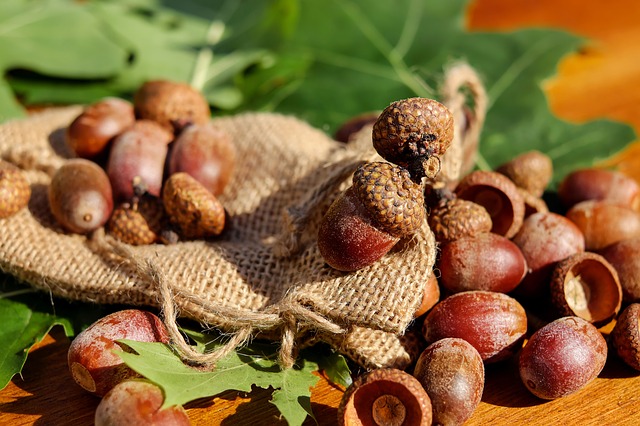It’s fairly easy to find a variety of wild plants that are edible — but they have a downside. Most leafy, green wild plants are very low in calories, and especially calories from fat.
On average, an active adult needs at least 2,000 calories a day to sustain his or her weight. Just as important, calories from fat do the best job of generating body heat in the cold temperatures of winter. That’s where edible wild nuts come into play. Of course, you could always supplement your diet with meat, but when nothing shows up on four legs, you might need to think seriously about nuts such as acorns, walnuts and chestnuts.
1. Acorns
Acorns appear on oak trees in late summer and fall. You can pick them off the tree or off the ground, but you might have some competition from local squirrels.
You’ll also need to do some prep work, which essentially involves shelling the nuts and soaking them in water to leach out the bitter tannins. The bitterness varies depending on the oak variety, but most require a good soak in warm water for a few hours. You may also have to do a second and third round of soaking if the acorns are particularly bitter. A taste test between soakings is the only way to assess when they’re ready.
You could also put the acorns into a fine-mesh net and soak them in a stream for a few days. The running water will do a great job of rinsing out the tannins.
Dependable Backup Power in any situation.
Some people will then dry the acorns and crush them into a flour. They can be used as a substitute for flour in any recipe, although cookies seem to be the best bet. (Learn how to make acorn flour here.)
You also could roast them in a dry frying pan over an open fire for 15 to 20 minutes. Toss them from time to time, or put them on a baking sheet in a 375-degree (Fahrenheit) oven for 15 to 20 minutes. I usually salt them lightly before roasting and eat them like peanuts.
2. Black walnuts
Black walnuts are easy to find. Their large, green husks will often litter the ground beneath the tree. You can try to shake a few down or do what my brothers and I used to do — throw some walnuts up into the tree and try to knock a few more down.
The outer husk of a black walnut is bright green, but wear gloves when you collect them. They will actually stain your hands black, which is the genesis of the name “black” walnut. You’ll need to remove the outer husk. This can be done by rolling a nut underfoot on a hard surface or using a hammer to crack and loosen the outer husk.
Story continues below video
Once you have shelled the walnuts, rinse them in a few changes of cold water. The water will turn black and you should continue to soak and rinse them until the water runs clear. Putting a hose into a five-gallon plastic bucket filled with walnuts works pretty well, but make sure the dark water runs off into an area where the stain will not affect a deck, sidewalk or patio.
Black walnuts are high in Omega-3 fatty acids and proteins, and have been shown to lower cholesterol and to act as an anti-inflammatory. The nuts in the shell are also difficult to crack open. Traditional nutcrackers often won’t work, so you may be back to the hammer or a vise. Wear goggles when you’re cracking them open because they can splinter. Separate the nutmeat from the shells and you’re ready to eat.
3. Chestnuts
Yes, you can roast them on an open fire but make sure you have the right variety of chestnut. Horse chestnuts are toxic, while the sweet (English0 chestnut is not. If you’re not sure of the variety of chestnut you may have found, bring one home and check the Internet to identify the variety.
Chestnuts are surrounded by a hard, spiky shell. Wear gloves when you gather them and try to remove the outer shell as soon as possible. The chestnuts can be eaten raw, but I prefer to roast them. This can be done either in an oven or over a fire.
Story continues below video
If roasting in an oven, preheat the oven to 400 degrees (Fahrenheit) and cut an “x” into each one of the chestnuts. Place them on a sheet of foil and roast for 30 minutes. The inner shells will crack open at the incisions you made and are easier to peel when still warm.
If you’re going to roast over a fire, use a cast iron frying pan. Cut the shells in the same way and toss the nuts from time to time in the pan. Thirty minutes should do the trick, or you can try one from time to time to see how they’re doing.
Fall is the best time to harvest edible wild nuts, but regardless of when you pick them, discard any nuts that look damaged by insects or have nutmeat that appears to be off-color compared to the rest of the nuts you’ve gathered. Happy hunting!
What is your favorite wild nut? What advice would you add? Share it in the section below:
 Off The Grid News Better Ideas For Off The Grid Living
Off The Grid News Better Ideas For Off The Grid Living




